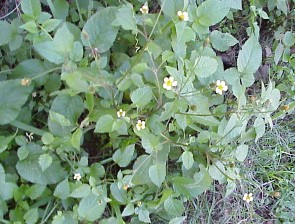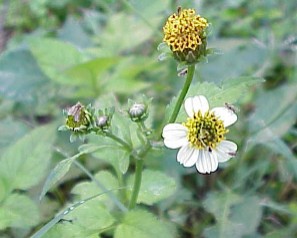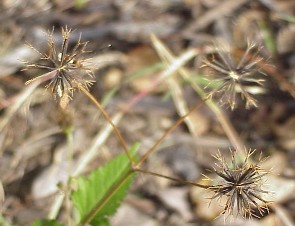Scientific name: Bidens pilosa L.
Common name: Cobbler’s pegsFamily: AsteraceaeOrigin:This species is cosmopolitan in warmer regions of the World. Habit:Annual herb with erect habit to 1.5 m in height. Habitat:This is a common weed of tended areas, especially closer to the coast. General description:Stems and leavesStems are square in cross section (ie. quadrangular), mostly hairless and green to purplish in colour. The leaves are oppositely arranged with leaf stalks (petioles) 1-6.5 cm long. Their margins have forward pointing teeth (ie. serrated). Leaf blades vary in shape. At the base of the plant, leaves tend to be simple and more or less oval in shape, higher up the plant leaves are mostly compound (pinnate) with 3-7 egg-shaped (ovate) leaflets, and the uppermost leaves are smaller and simple or with 3 leaflets (trifoliolate). Leaf or leaflet size varies from 1.5-7 x 0.5-3.5 cm. Flowers and fruitFlower-heads are 7-8 mm across with yellow central (tubular) florets. Some plants have flower-heads with white or cream ‘petals’ (ray florets) up to 1.5 cm long, however these 'petals' may be absent or quite small. Heads are arranged in branched inflorescences at the ends of the branches. Flowering occurs over most of the year. The seeds are black, flattened, linear in shape (0.4-1.6 cm long) with a row of two to four barbed awns (2-4 mm long) at one end. Distinguishing characteristics:An annual herb with simple or compound leaves, oppositely arranged leaves. Flower-heads are small and yellow, sometimes with white 'petals'. Seeds have distinctive barbed awns which adhere to clothing and fur. Noxious status:Not noxious. Sources:Kleinschmidt, H.E., Holland, A. and Simpson, P. (1996). Suburban Weeds. 3rd Edition. Department of primary Industries, Brisbane. Stanley, T.E. and Ross, E.M. (1983-1989). Flora of South-eastern Queensland. Volume 2. Department of Primary Industries, Brisbane. |
Brisbane
St Lucia, QLD 4072
+61 7 3365 1111
© 2009 The University of Queensland




